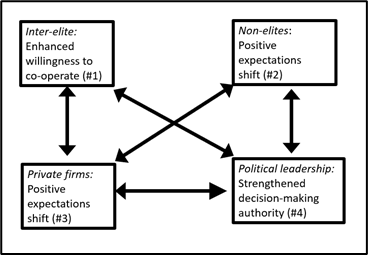Blog
Virtuous circles and downward spirals
The power of ideas & the limits of technocracy
What will it take to shake loose the distemper of our times, and initiate a virtuous spiral of renewal? In a recent UNU-WIDER webinar, Alan Hirsch and I explored why a narrow focus on growth and good governance will not be enough to get South Africa (and, by analogy, other countries similarly trapped in a vicious cycle of disillusion and despair) back on the path of building a thriving, inclusive society. Conventional policy discourses are well-suited to address circumstances and questions such as these: How to maintain rapid growth, while making it increasingly inclusive? Assuming political and social stability, and taking a medium-to-long-term horizon, what policy and expenditure decisions will best achieve the country’s development goals? These are public policy challenges for a season of hope.
However, South Africa (and numerous other countries) no longer is in a season of hope. Growth has ground to a halt; inequality festers; institutions decay; the threat of accelerating turmoil looms. The frontier challenge is not one of making mid-course adjustments, while sustaining momentum; it is a challenge of renewal, of setting in motion a new virtuous spiral. Addressing this challenge needs a broader approach to crafting a way forward than is provided by the conventional tools – one that goes beyond the technical details of policy, and looks also at policy’s inter-relationship with perceptions, expectations and power. The UNU-WIDER webinar and a background multi-author Carnegie paper 'South Africa: When Strong Institutions and Massive Inequalities Collide' use this broader perspective to explore how South Africa might find its way back onto a path of inclusive growth. This post lays out the underlying logic.
Perceptions and power – the ideas that people have about how the world works and their place in it – play a central role in driving the ebb and flow of economic and political momentum. As the figure below highlights, interactions among four drivers are the fuel for virtuous (and vicious) spirals:
- Ideational driver #1: whether political and policy choices are perceived as zero-sum, or prioritize a search for win-win, co-operative options;
- Ideational driver #2: perceptions across a broad swathe of a country’s citizenry as to the legitimacy and fairness of prevailing political and institutional arrangements;
- Ideational driver #3: whether expectations of the future are optimistic or pessimistic.
And (as influenced by each of the above)
- The strength of political leadership’s decision-making authority.
Consider ideational driver #1: All-too-often political discourse is framed in zero-sum, ‘my-way-or-the-highway’ terms. This is mistaken. As Bill Ferguson has spelled out in detail, an extraordinarily wide range of public challenges (from budgeting, to the governance of public agencies, to community service provision) are better understood through the lens of co-operation and its challenges.

What shapes the propensity to co-operate? As game theory teaches, one key determinant of whether win-win or more narrowly zero-sum approaches predominate comprises the time horizon of protagonists. Longer time horizons, and thus repeated interactions, support co-operative outcomes. This time horizon is influenced directly by ideational drivers #2 and #3.
Ideational driver #2’s relevance is highlighted by Francis Fukuyama. Perceptions of legitimacy and fairness are foundational for a thriving society, he argues, because:
'Political power is the product not just of the resources and numbers of citizens that a society can command but also the degree to which the legitimacy of leaders and institutions is recognized. Legitimacy means that the people who make up the society recognize the fundamental justice of the system as a whole and are willing to abide by its rules….'
These perceptions are, of course, subject to change. As Albert Hirschman taught us, perceptions of fairness and legitimacy need periodic reinforcement, else hope can all too readily turn to anger – with, as per the figure, the ideational turn cascading throughout society.
Ideational driver #3 was a centerpiece of John Maynard Keynes’ analysis of the influence of expectations of the future (and their volatility) on private investment and economic growth. As Keynes put it:
'[Private] investment depends on judgments about the future which do not rest on an adequate or secure foundation……..Our theory of the future is subject to sudden and violent changes. The practice of calmness and immobility, of certainty and security, suddenly breaks down. New fears and hopes will, without warning, take charge of human conduct…..'
Interactions between expectations and growth on the one hand, and ideational drivers #1 and #2 on the other, are two-way. In one direction: rapid growth (especially when it is inclusive) enhances opportunities, fuels hope and lengthens the time horizons of both emerging elites and non-elites. In the other: a more co-operative orientation among elites and enhanced perceptions of legitimacy and fairness on the part of a broad swathe of society each can bring greater optimism as to what the future may hold, thereby helping to fuel private investment.
The fourth driver – the decision-making authority of political leadership – both fuels and is fueled by the other three. As the figure suggests, political leaders can support a virtuous circle by being decisive in their decision-making. The degree of decisiveness depends, in part, on how a leader chooses to lead. It also depends on the context within which that leader is embedded: Hopeful expectations; commitments among elites to co-operate, despite their differences; and a perception across society that the rules of the game are legitimate and fair – all of these add to the ability of political leaders to effect change.
How to get a virtuous spiral underway? This takes more than understanding the drivers and their interdependencies – the crucial challenge is to identify entry points capable of providing sufficient momentum to kickstart the process. Momentum won’t be shifted by yet another round of pronouncements of policy intent. Their limitation isn’t only one of the unlikelihood of action, there is a chicken-and-egg problem. Even were the standard menu of growth, governance and inclusive reforms to be implemented, it would take some time for them to have a discernible effect on peoples’ lives – but until that effect is evident, the reforms will do little to move the needle on the ideational drivers. And the medium-run on which reform packages focus is unlikely to arrive unless action is sufficiently bold to shift expectations.
One way to rapidly reshape expectations is to address directly the challenge of fairness and legitimacy. How to do so in ways that fuel hope rather than fear, anger, recrimination and pushback by elites threatened by change? Key in the South African context is for reforms along the lines of what we call in the Carnegie paper ‘growth-compatible redress’. Such redress would include initiatives that can make an immediate difference in the lives of the marginalized, complemented (or perhaps even superseded) by approaches to redress that are sustainable and supportive of investment in capabilities over the longer-term, thereby helping to accelerate upward mobility – with the package underpinned by more conventional policy and governance reforms. (Appendix B of the Carnegie paper, pp. 73-76, provides more detail of what such reforms might comprise.)
Expectations might also be shifted in virtuous-circle-initiating ways through action on the leadership and governance fronts. While rebuilding institutional capacity takes time, credible signals that the game has changed can be sent quickly, and can rapidly alter incentives and behavior. Bold actions that leaders might take to signal such a shift could include:
- A willingness to work in coalition with rivals – as a potent and highly visible way to strengthen mutual accountability.
- A corresponding willingness to break loose from the deadweight of so-called allies stuck in endless stale discourses whose practical consequence is a reproduction of the status quo and a defense of narrow parochial interests. And
- A broader invitation for a new kind of active citizenship across a broad range of stakeholders – one that prioritizes co-operation around win-win possibilities.
(Click here for some additional discussion of these options.)
As an economist by training, I know that it can be discomfiting to turn attention away from the seemingly solid ground of technocratic discourse towards the more squishy terrain of perceptions and power. Yet doing the same thing again and again and expecting a different result the next time is not a recipe for success. Can societies stuck in a deep hole of disillusion, anger and despair find the political and policy imagination and moral courage to do things differently?
The views expressed in this piece are those of the author(s), and do not necessarily reflect the views of the Institute or the United Nations University, nor the programme/project donors.
This article is republished from Working with the grain with permission. Read the original article here.
 Join the network
Join the network


